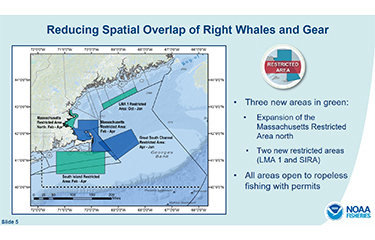NOAA Fisheries has announced a set of new regulations intended to protect the North Atlantic right whale from entanglement-related incidents. The regulations will cost the Northeast lobster fishery between USD 9 million and 20 million (EUR 7.6 million and 16.9 million) to implement.
The new regulations are in response to the ongoing decline of the highly endangered whale, of which only a few hundred remain in the wild. The species is currently undergoing what NOAA has dubbed an “unusual mortality event,” with 34 right whales having died since 2017.
The main objective of the rule is to reduce the number of vertical buoy lines in the water through planned seasonal area closures. The South Islands area south of Cape Cod will be closed to fishing from February to April, and the LMA 1 area of the Maine coast, which comprises a roughly 967-square-mile area, will be closed to fishing from October through January. A key part of the new closure will allow “ropeless” fishing gear to be used in the area even during closures.
Marine Mammal Take Reduction Team Lead Marisa Trego said during a 31 August NOAA press conference the closure of LMA 1 is expected to impact around 62 Maine-based fishing vessels.
The new rules will also require that fishermen include weak points in lines so that whales can break free without becoming seriously injured -the lines must have a breaking strength of 1,700 pounds. In addition, lines will require new markings that will allow NOAA Fisheries to identify what fishery it is from, which port it was fished from, and whether it was used in state or federal waters.
“It won’t be required until May 2022,” Trego said of the new rules. “But the closure of LMA 1, given it’s a fall closure, will be in effect 30 days after it is published in the Federal Register.”
Trego predicted the new rules will be published soon enough that this fall will likely feature the first closure of LMA 1 to lobster fishing. She said there is not currently federal funding available to help fishermen purchase the new gear required.
“We don’t have funding available as far as I know from the federal government, [though] there are some states that are offering funding,” Trego said.
The new regulations received a mixed reaction from both fishing and conservation organizations. Organizations advocating for lobster fishermen said that the new regulations go too far, citing a lack of evidence the lobster fishery causes any deliterious impact on right whales. The Protect Maine’s Fishing Heritage Foundation called on state and federal authorities to “do all they can to change the decision” on the new right whale rules.
“This is incredulous. Maine lobstermen and women are not killing right whales. Why would you penalize an iconic Maine industry for the sake of being able to say you are saving right whales? It’s like cutting off an arm when it’s the foot that is the problem and pretending you have fixed the problem,” PMFHF Executive Director Crystal Canney said.
Conservation organizations also criticized the rules, saying they didn’t go far enough to protect right whales.
“We can’t save this rapidly declining whale population from extinction with half-measures like this,” Center for Biological Diversity Legal Director for Oceans Kristen Monsell said in a release. “This plan is better than nothing and a step in the right direction. But we’ve already waited far too long to protect North Atlantic right whales from deadly entanglements. It’s time to get all vertical fishing lines out of important right whale habitat immediately and convert to on-demand ropeless fishing gear.”
In its own statement, environmental NGO Oceana said the new rules won't adequately protect right whales.
“After four years of rulemaking, it’s disheartening that despite the legal obligation to be stewards of North Atlantic right whales and help them recover, the government has once again failed to take aggressive action,” Oceana Campaign Director Whitney Webber said. “With only around 360 whales remaining, there is no room for shortsighted solutions. We can recover this species, but it will take meaningful, strong regulations to keep deaths below one per year – the level the National Marine Fisheries Service says is needed to support recovery.”
The new rules are part of NOAA Fisheries ongoing efforts to protect right whales, and stem from a biological opinion published by NOAA Fisheries in May 2021.
A federal judge declared in 2020 that the U.S. lobster fishery was violating the Endangered Species Act due to the lack of an incidental take statement in its biological opinion. The opinion published in May rectified that, NOAA Greater Atlantic Regional Fisheries Office Regional Administrator Michael Pentony said during the press conference.
“We are convinced that that document addresses the concerns and issues in that previous [ruling],” he said. “This rule is a part of the larger conservation framework that was under that biological opinion in May.”
Image courtesy of NOAA Fisheries







